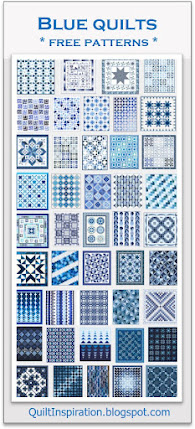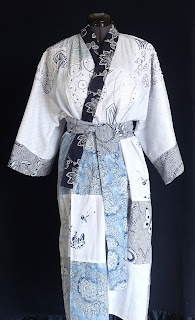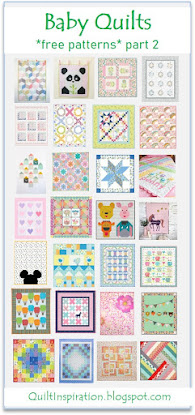Painted Sun, 2003, 24" x 24"

"Painted Sun" was featured on the cover of The Journal of Organic Chemistry in 2007. The quilt is composed of 16 blocks that are all the same, but rotated in different directions. We're fascinated by the unique geometric design. Note that the individual fabric shapes are either triangles or asymmetrical 4-sided objects (quadrilaterals). However, the irregular shapes create regular patterns. The center 4 blocks come together to form a diamond, with rays that radiate out from the center, like the sun. (At the end of this post, we'll analyze the blocks further*).
Monkeying around and around, 2003, 58" x 50"

To construct "Monkeying around and around", Lorrie started with a monkey wrench block (such as this one) and kept adding more triangles, then used Photoshop to give the whole thing a "twist". The curved shapes and subtle shading help to create the appearance of a three-dimensional spiral. The piece is heavily quilted, adding to the surface texture.
Thesis II (detail view), 2003, 56" x 56"

"Thesis II" was featured on the cover of Rethinking Rights and Regulations: Institutional Responses to New Communications Technologies, a book edited by Lorrie Faith Cranor and Steven S. Wildman. Lorrie placed the colors so as to achieve fairly strong contrast and bring out the patterns of the design. Many different colors of thread were used in the quilting. The "windows" were machine reverse-appliqued in a shiny translucent pink fabric after the quilting was completed.
Circular Reasoning, 2002, 37" x 37"

"Circular reasoning" was featured on the cover of The Routledge Handbook of Sociolinguistics Around the World. We love the pop-art feel of this quilt. The background is a blue grid with watercolor quilt style gradations, while the foreground is the concentric circles, which appear to hover in space. For embellishment, Lorrie used yarn for couching around the circles, and perl cotton thread for some big stitch hand quilting (for a view of the fabulous detail, click here).
*From octagon to "Painted Sun": We were fascinated by the geometric shapes in Painted Sun, and curious as to how the blocks were constructed. According to Lorrie, the design was generated by drawing an octagon; connecting all of the points; chopping off the top, bottom, left, and right points; and dividing the remaining square into quarters. At first, we couldn't quite see it. After a bit of reverse engineering, though, you can see that it is both logical and ingenious:

Quilt images, courtesy of Lorrie Faith Cranor.
Traditional monkey wrench block example, see Block Crazy.
Octagon block analysis, by Quilt Inspiration.











I always enjoy visiting your blog and seeing other people's quilts.
ReplyDeleteIt is definitely a source for inspiration. Thanks for blogging!!
Lorrie Cranor's quilts are works of art. I love that she's an engineer; you would need to be to create these patterns. Thanks for sharing.
ReplyDelete